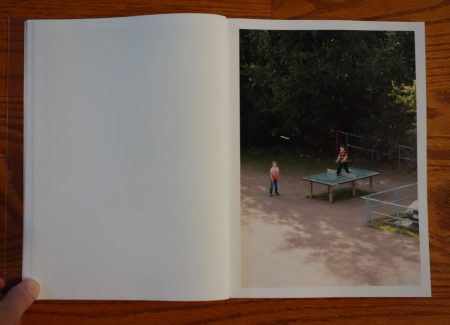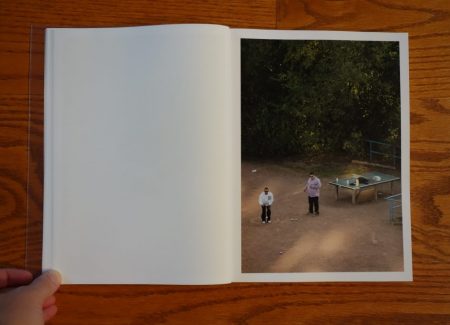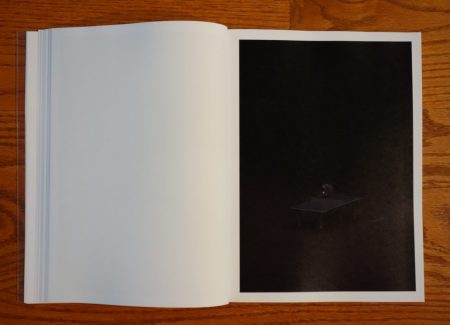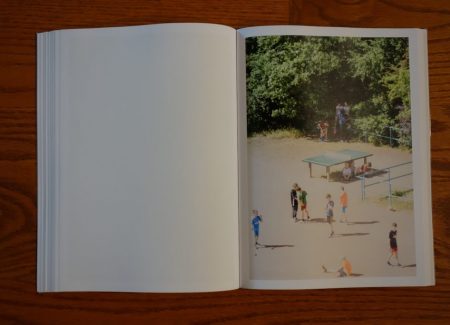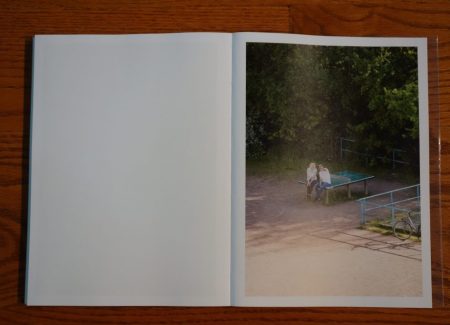JTF (just the facts): Published in 2018 by MACK Books (here). Softcover with clear PVC dust jacket, 260 pages, with 110 color reproductions. Includes a text by the artist (printed on the back cover). Design by Oliver Boualam and Lukas Marstaller. Winner of the MACK First Book Award 2018. (Cover and spread shots below.)
Comments/Context: Even though a photograph is normally bounded by the short length of its exposure, that hasn’t stopped countless image makers across the history of the medium from using photography as a vehicle for examining the slow passing of time. By limiting themselves to relatively fixed compositional rules and then repeating the process of picture taking again and again over time within those same constraints, these photographers have crafted rich, long term projects, multiplying the framework of a single static image out into a robust series.
For the American photographer Nicholas Nixon, his simple annual portrait of his wife and her three sisters, now reaching into its fifth decade, has become a sensitive study of familial relationships, aging, and the extended rhythms of life. And in the case of the Czech photographer Josef Sudek, who photographed the same scene outside his studio window for nearly twenty years (beginning during World War II), the combination of seasons, weather, a lone tree, the surrounding garden and fence, the window pane, and a few still life items perched on the interior sill provided a nearly infinite variety of ways to express the subtle contours of his changing emotions.
Hayahisa Tomiyasu’s understated photobook TTP fits neatly into this serial tradition. The unlikely backstory to the project starts with an urban fox, fleetingly seen by the artist in the bushes of contemporary Leipzig. A few weeks later, Tomiyasu spotted the fox again, this time down on the athletic fields outside his student dorm, glimpsed from the window of his room on the 8th floor. As he scanned the nearby area hoping to see it again, he noticed a small soccer field, an indoor swimming pool, a running track, and near the edge of the park area, a single ping pong table.
Over the next five years, Tomiyasu would ultimately make hundreds of images of this very same ping pong table, from the specific vantage point of his room, capturing it in different seasons, at different times of the day, in different weather conditions, and most curiously, in a dizzying variety of uses, none of them actually the playing of table tennis. TTP (a shortening of the German word tischtennisplatte) gathers a thick selection of these images together, the lonely piece of city property becoming the artist’s surprisingly vibrant entry point into the world around him.
Day after day, the ping pong table silently endured what the park goers and the environment could dish out. Athletes used it for calisthenics and yoga. People sat on it, or rested for a while. Kids played on it, under it, around it, basically all over it. The table became a storage unit for backpacks, clothing, and other stuff, and a handy spot for picnics, buffets, and gatherings. The weather turned snowy, and then rainy (with muddy puddles pooling at its feet), and then bright and summery, with weeds growing up underneath. Birds, dogs, and other animals investigated the table. It provided shelter, a place to lean, a moment of solitude, and even a flat spot for a nap. And it became the unexpected venue for dog grooming, diaper changing, bicycle repair, laundry folding, remote control car testing, snowball fight organization, and running race refueling. With each turn of the page, Tomiyasu offers yet another unexpected activity taking place at this handy location.
While this clever taxonomy of human behaviors is undeniably engaging, the sequencing of the images goes further to highlight some of the formal patterns to be found in the pictures. Tomiyasu shows us various people standing on the table, objects in flight (arrow, snowball, flying ring, ball, bird), a series of bodies leaning in different gestural ways, people gathering to take pictures or tell secrets, echoes of kicks, repetitions of solitary figures and then pairs, a series of tumbles, and near the end, a selection of bare bottoms. These additional layers of compositional repetition integrate the disparate images, giving them an almost musical refrain.
Given the exacting sameness to the framing of the images in this book, it makes sense that the design of TTP sets the photographs into a lock step, right page parade. What’s unexpected is that the rest of the book is effectively turned inside out, with the explanatory text pulled out and printed on the back cover and the colophon/copyright information printed on the spine. This smart inversion removes unnecessary distractions and delays, and redirects the reader’s attention back to tracking the changes taking place at the table.
The last images in the book offer a pair of questions. The first captures two people sitting on the table, pointing in the general direction of where Tomiyasu was standing when he took the images, and while we can’t be sure whether they are actually pointing at him or not, the gesture reminds us of the voyeuristic nature of these pictures – they seem to be saying “we see you”. And the last image watches as the table is lifted by a backhoe. Is it being removed or perhaps being placed their for the first time? This time twist leaves us wrong-footed and wondering, unsure of the play of time we thought we understood.
For a rigid single-subject project, Tomiyasu’s TTP is satisfyingly complicated and layered. It has an obviousness that is endearing, and that clarity certainly makes it memorable. But it’s the depth of humanity that that Tomiyasu has found surrounding this lowly ping pong table that will bring us back to TTP. It might forever be referred to as “that ping pong table photobook” but such a catchphrase only reinforces its easy-to-appreciate durability.
Collector’s POV: Hayahisa Tomiyasu is represented by Galerie b2 in Leipzig (here). His work has little secondary market history, so gallery retail likely remains the best option for those collectors interested in following up.



